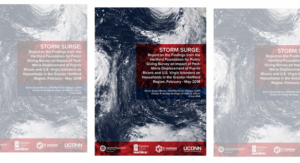STORM SURGE: Impact of Post Maria Displacement of Puerto Ricans and U.S. Virgin Islanders on Households in the Greater Hartford Region

Executive Summary
On September 20, 2017, Hurricane Maria struck Puerto Rico as a category 4 cyclone, with minimum sustained winds blowing at 145 mph, peaking at 155 mph as it made landfall. The northwest trajectory of the storm assured that the entire island would be affected by its effects. One month henceforth, the island’s authorities indicate that 49 people had died as a direct result of the hurricane. The Puerto Rican government figures indicated 64 deaths were directly related to the hurricane, even though journalistic accounts pointed to more than 1,000 deaths and a Harvard University Study estimated the count at 4,645.1 In addition, more than 80 percent of consumers lacked electric service and 20 percent lacked potable water.2 Six months after the storm, 15 percent still lacked electric service and 12 percent lacked potable water. Furthermore, preliminary estimates by the government of Puerto Rico indicate that approximately 70,000 residential properties were totally destroyed, with an additional 300,000 partially damaged residences. As of February 2018, 1.1 million households had applied for disaster aid from the Federal Emergency Management Agency (FEMA). FEMA reports that it has approved more than 455,000 applications for individual assistance.3 The devastation caused by the hurricane, and the limited and insufficient response from government authorities at every level, has resulted, among other things, in a massive out flow of residents from the island, to destinations in the United States, including the state of Connecticut. In light of the severity of the consequences of hurricanes Maria and Irma in the Caribbean, The Hartford Foundation for Public Giving (Hartford Foundation) issued a request for proposals for a brief survey on the impact on the Hartford region of post-disaster displacement, in anticipation that people displaced by the hurricanes might relocate to the area. The Hartford Foundation was concerned about the lack of information about the probability that people from the Caribbean region displaced by the cyclones would relocate to the Greater Hartford Region (GHR) and the magnitude of the number of individuals who might relocate. By sponsoring such a brief survey, The Hartford Foundation would contribute to fill the void in information, and in doing so, allow for the planning and the contingency preparations of non-for-profit organizations, municipalities and schools in the Greater Hartford Region.
Summary of Key Findings
Puerto Ricans in Connecticut are already feeling the aftermath of hurricanes Irma and María. Fully one quarter of Puerto Rican respondents in the Greater Hartford Region are harboring people displaced by the cyclones. The overwhelming majority of these displaced arrivals in Connecticut have been staying with friends or relatives for several months. Moreover, their likelihood to stay in Connecticut appears indefinite, with one third unsure of how long they will remain in the state and nearly another third expecting to remain for several years. In addition, the majority of survey respondents expect more relatives or friends to travel to and remain in Connecticut for months or years. T he influx of displaced Puerto Ricans has resulted in pressing needs for Puerto Rican households in Connecticut. Survey respondents identify housing issues and insufficient food as the most critical needs they are facing in Connecticut, along with healthcare, in the aftermath of the crisis. These are needs not only of those who are in the state already, but of those who are very likely to arrive in the short-term. These needs are adding a heavy responsibility on an already over-extended and resource-limited Puerto Rican community in Connecticut, given the extreme levels of need that are present in the community and that pre-dated the crisis created by hurricanes Irma and Maria. Survey findings indicate a great level of poverty among respondents, with an overwhelming majority of them living in households classified as low income and two-thirds meeting the federal definition of poverty. Survey respondents report needs everywhere, though most critically concentrated in the city of Hartford and radiating from there to the surrounding towns in the region.
Download Report
Authors
- Carlos Vargas-Ramos
- Charles R. Venator-Santiago